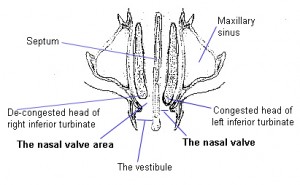Nasal patency is predominantly controlled by changes in the capacitance vessels. Nasal airway resistance is responsible for approximately two thirds of the total airway resistance. Primary sites of nasal obstruction to airflow include the nasal vestibule, the nasal valves, and the nasal turbinates (Fig 1). 
The nasal valve, the location of minimal crosssectional area of the nares, contributes most to total nasal resistance (NR). The entire nasal valve area resembles an inverted cone. It is bounded by the nasal septum medially, posterior end of the upper lateral cartilage, piriform aperture (lateral fibrofatty tissue, frontal process of the maxilla, floor of the nose), and the anterior head of the inferior turbinate posteriorly. This functional complex of compliant and dynamic tissues covers a distance of several millimeters. The valve lumen is regulated by lateral and medial erectile mucosa, modulated laterally by the tone of alar muscles, and stabilized by bone and cartilage. Septal erectile tissue, although not readily recognizable endoscopically, is clearly demonstrated by CT and histologically in cadaver studies.
NR is greatest during infancy, decreases with age, and is primarily controlled by vascular engorgement in the middle and inferior turbinates. Exercise increases sympathetic discharge, which vasocon-stricts the nasal capacitance vessels thereby decreasing nasal airflow resistance. Similarly, sympathomimetic medications Canadian pharmacy viagra, such as oxymetazoline, decrease nasal congestion via topical vasoconstriction.
The physiologic variation in nasal patency, known as the nasal cycle, is mediated by changes in the engorgement of the submucosal capacitance vessels in the middle and lower turbinates. The magnitude of NR alternates between the two nasal cavities every 2 to 4 h in 60 to 70% of healthy individuals. Posture also influences the degree of vascular congestion. Nasal obstruction increases bilaterally as a subject assumes the supine position, and increases in the dependent nasal passage in the lateral recumbent position. This may have implications in the development of SDB in susceptible individuals.